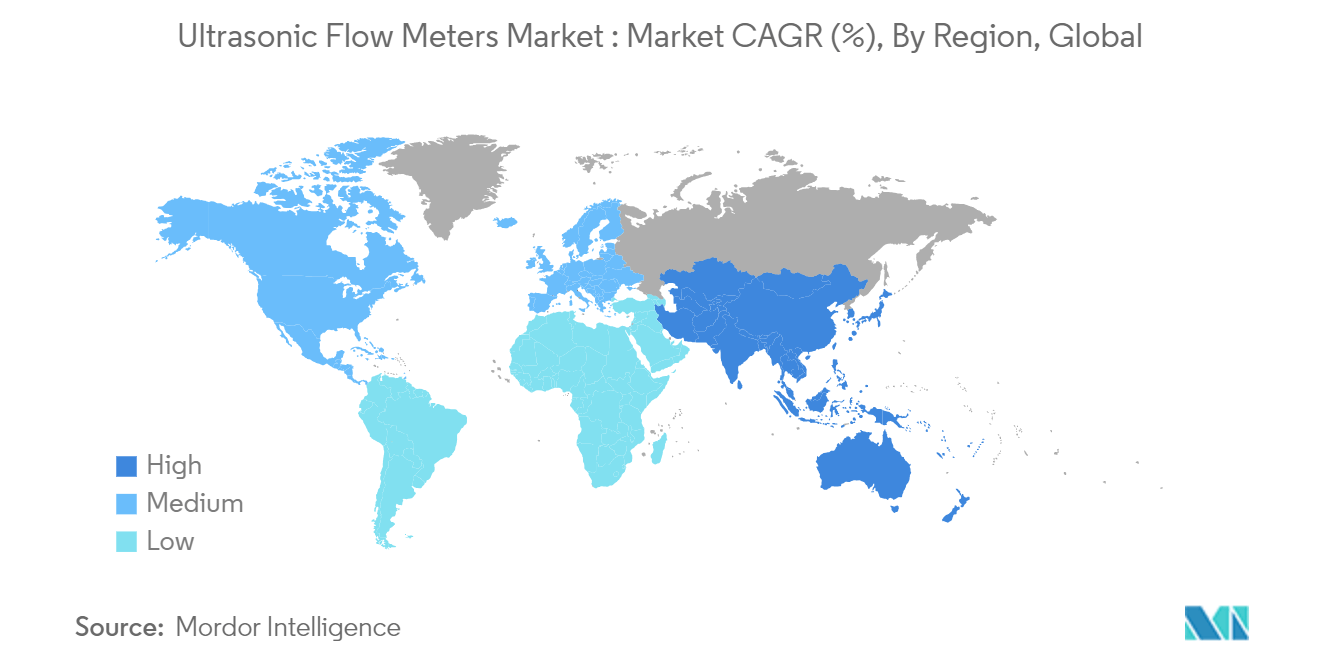Market Trends of Ultrasonic Flow Meters Industry
The Clamp-on Mounting Method is Expected to Grow Significantly
- Clamp-on ultrasonic flow meters are noninvasive devices used to measure the flow of liquids or gases in pipes without cutting into the piping system. They utilize ultrasonic technology to determine the fluid's velocity by sending and receiving ultrasonic signals through the pipe wall.
- These flow meters typically consist of two ultrasonic transducers clamped onto the pipe’s outside. The transducers emit ultrasonic pulses that travel through the pipe wall and into the fluid. The meter can calculate the flow velocity based on the transit time principle by measuring the time it takes for the ultrasonic signals to travel upstream and downstream. This method is effective for various types of fluids, including those that are clear or contain some level of particulates.
- Clamp-on ultrasonic flow meters are extensively used in water treatment plants and wastewater facilities to monitor flow rates and manage distribution systems. Their noninvasive nature allows for easy installation on existing pipelines without interrupting service, making them suitable for utilities seeking to optimize water usage and enhance the efficiency of treatment processes.
- Integrating smart technologies and IoT (Internet of Things) into industrial processes creates new opportunities for clamp-on ultrasonic flow meters. These devices can be equipped with wireless communication capabilities, allowing for real-time monitoring and data analysis, which enhances operational efficiency and decision-making.
- For instance, according to GSMA (Global System for Mobile Communications), the global number of Internet of Things (IoT) connections is expected to grow almost linearly through the period from 2020 to 2030, with an expected number of about 24 billion enterprise IoT connections in 2030. Hence, an increase in enterprise IoT will further drive the IoT penetration in Clamp-on ultrasonic flow meters across different industrial applications.

Asia-Pacific is Expected to Register Major Growth
- Ultrasonic flow meters are clamp-on or in-line devices that do not require any penetration into the oil and gas pipeline, which reduces the risk of gas or oil leakage and contamination, especially for hazardous or corrosive fluids. The increasing output of oil and gas, metals, and mining in Asia-Pacific has the potential to boost market demand even more.
- As the demand for oil and gas increases, the sector is witnessing notable growth in investments to enhance its capacity. For instance, in February 2024, the Indian Government announced a strategic investment plan of USD 67 billion for the Indian gas sector over the next 5-6 years. Such rising investment in the country's oil and gas sector will positively impact market growth.
- Ultrasonic flow meters are gaining traction in the region, driven by the rising production and sales of electric vehicles (EVs) and the government's strong push for EV sales. The government is prompted to enforce stringent emissions regulations due to the increasing automotive sales in the nation to prevent significant environmental repercussions.
- Moreover, the Indian electric vehicle (EV) market is projected to achieve a value of USD 7.09 billion (INR 50,000 crore) by 2025. According to a report from the CEEW Centre for Energy Finance, there is a potential USD 206 billion opportunity for electric vehicles in India by 2030, which will require a significant investment of USD 180 billion in vehicle manufacturing and charging infrastructure.
- Further, according to CAAM, China's new energy vehicle sales amounted to 597,000 units, of which 559,000 were passenger electric vehicles and 38,000 were commercial electric vehicles. In electric vehicles, ultrasonic flow meters are pivotal in enhancing thermal management, leading to boosts in efficiency, safety, and durability, thus gaining more popularity in the EV sector.


